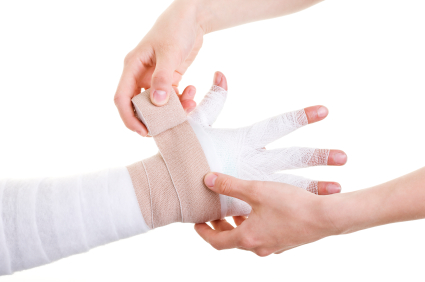Services – Lymphoedema Management
The goal of lymphoedema management is to reduce the lymphoedematous swelling to a normal or near normal size utilising remaining healthy lymph vessels and other lymphatic pathways. Once the lymphoedema is decongested, the secondary goal is to maintain the reduction and to prevent the re-accumulation of lymph fluid. These goals can be achieved with a treatment known as Decongestive Lymphatic Therapy (DLT). You may also know this as Complete Decongestive Therapy (CDT).
Effective DLT can be obtained by paying attention to skin care, decongestive exercise, manual lymphatic drainage and compression by way of bandaging and/or the wearing of compression garments. If you are at risk of lymphoedema, precautions also need to be taken when flying – even short distances.
Lymphoedema is classified into two groups – primary and secondary:
Primary lymphoedema represents a development abnormality (dysplasia) of the lymphatic system, which is either congenital or hereditary, including:
- Hypoplasia (incomplete development of lymph vessels)
- Hyperplasia (diameter of lymph collectors is larger than normal)
- Aplasia (absence of single lymph collectors, capillaries or lymph nodes)
Secondary lymphoedema (acquired from damage to the lymph system), including:
- Trauma eg burns
- Repeated bouts of local infection
- Removal of lymph nodes, radiation of lymph nodes (treatment of cancer)
- Lymphoma (cancer of the vessels)
- Surgery
- Immobility
DLT is not a “once off treatment” fix for lymphoedema. The staging of your lymphoedema will determine your treatment regimen, but no matter the stage, having an awareness of your risks, taking necessary precautions in your activities of daily living (eg bandaging affected limb or wearing a garment on flights) and being compliant with your treatment and self-care will help you keep on top of things.
Your appointment can include a vascular assessment to rule out contraindications such as peripheral artery disease prior to any compressive treatments. I utilise the sequential intermittent pneumatic compression sleeve and low level laser therapy. Low level laser therapy gives good results for breaking down fibrosis and stimulating lymphatic flow.
Lymphoedema Management
60 minutes- Your appointment includes health history/consultation as well as any of the following:
- Measurements as required
- Manual Lymphatic Drainage (MLD)
- Use of low level laser therapy and/or sequential intermittent pneumatic compression pump
- Education on risk factors, self-massage, garments
- Information sheets on self-management
- Assessed for suitability for bandaging
- Letter to medical team (with your consent)
Lymphoedema Management
90 minutes- Update of health history and any of the following as appt time allows:
- Measurement check
- Manual Lymphatic Drainage (MLD)
- Check of your self-drainage technique
- Use of low level laser therapy/sequential intermittent pneumatic compression pump
- Letter to medical team (with your consent)
- Bandaging – extra charge for bandages, can take 20-30 mins per limb and usually done for 7-14 days after a trial of 24 hours in “loan” bandages to check your compliance
Gympie
By appointment only
Gympie
By Appointment only
Call us on 0402 988 423
to make a booking.
BANDAGES
If you are new to bandaging, you may be surprised at the quantity of material required to bandage just one limb. Short stretch bandages are used for your compression and it is recommended that you have two complete sets – one on and one in the wash. Kits are available for purchase as well as individual bandages as spares.
I also use Coban and Comprilan bandaging which is one use and can stay on for several days.
We can decide which style of bandaging will suit you by discussig your lifestyle, home help, activities of daily living.
GARMENTS
Once your lymphoedema is in its maintenance stage, garments can be ordered for you. These can take several weeks to arrive and are available “off-the-shelf” or “made-to-measure”. I carry stock of compression garments. Some patients may be eligible for a Queensland Health funded garment.
Frequently Asked Questions (FAQ)
I've had cancer, what are the risk factors for getting Lymphoedema?
How do I know if the swelling I have is lymphoedema?
Here at Lymphoedema Therapy, Training and Education we pride ourselves on specialised modalities for compromised health and Jacqui has training in Complex Decongestive Therapy (the management of lymphoedema). She will be able to tell you whether your “swelling” is oedema, lipoedema or lymphoedema and then implement a treatment plan in liaison with your medical practitioner.
What is the difference between oedema, lipoedema and lymphoedema?
Oedema
- Medical term for swelling
- An excessive accumulation of fluid, mainly water, in the tissue spaces of the body
- General response of the body to injury or inflammation
- May be local (at the site of the injury) or general
- Often affects specific organs (eg cardiac oedema – peripheral oedema due to congestive heart failure)
- General oedema is often treated with diuretics
- Local oedema is often treated by treating the underlying cause
Lymphoedema
- High protein oedema
- Is the accumulation of excessive amounts of protein-rich fluid resulting in swelling of one or more regions of the body. This is due to a mechanical failure of the lymphatic system and occurs when the demand for lymphatic drainage exceeds the capacity of the lymphatic circulation. Usually affects the limbs but can affect trunk, head, neck, breast and genital areas.
- Secondary lymphoedema is more common and develops due to damage to the lymphatic system eg cancer, removal of lymph nodes, trauma, self harm, venous disease, obesity.
Lipoedema
- Also known as “Painful Fat Syndrome” or “The Disease they call Fat”
- Lymphatics not involved but may lead to lymphoedema
- Lymph removal may be impeded by the fatty laydown and hip-lymphoedema then develops
- Tender to touch and looks like cellulite
- Feet not affected
- Chronic disorder of adipose tissue mainly affects legs à heavy, swollen, shapeless and painful to touch

